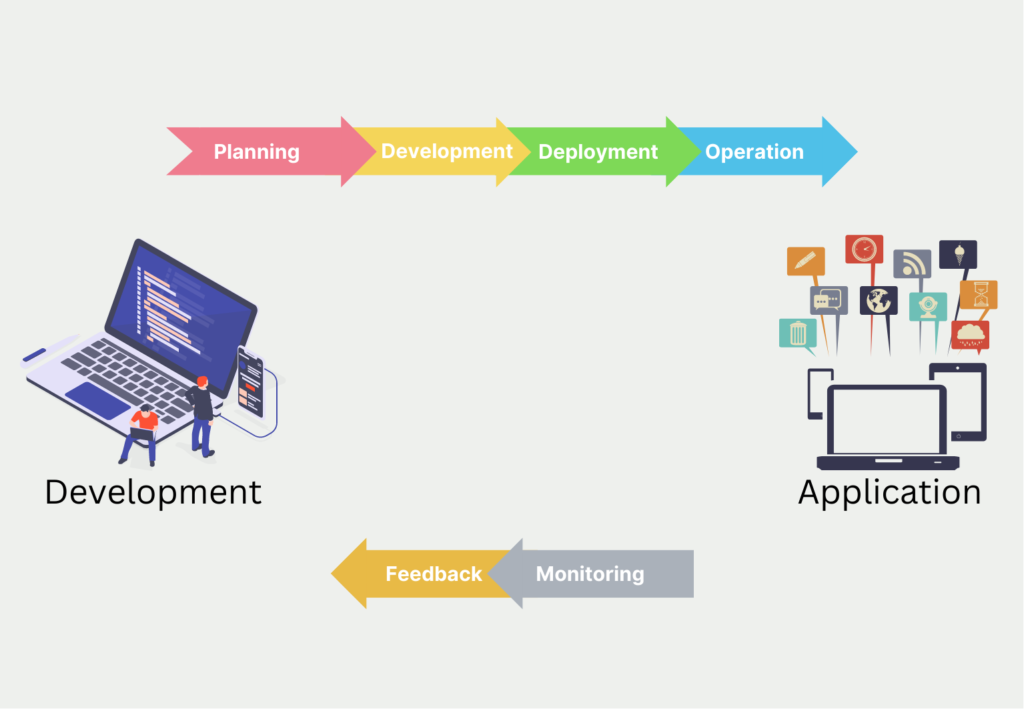MLOps, or Machine Learning Operations, is an emerging field that combines the principles of DevOps with Machine Learning to manage and streamline the Machine Learning lifecycle. It aims to automate the processes involved in building, deploying, and managing machine learning models in production.
Why is MLOps important?
As Machine Learning models become more complex and are applied to more critical use cases, the need for effective management and monitoring of these models in production has become increasingly important. This is where MLOps comes in, as it helps to streamline the lifecycle and ensure that models are deployed and managed effectively in production.
The concept involves a number of key processes, including:
- Data Management: MLOps involves managing large volumes of data and ensuring that the data is clean, accurate, and representative of the real-world scenarios that the model will encounter in production.
- Model Training: Once the data has been collected and preprocessed, it involves training the model using a variety of techniques, such as supervised, unsupervised, or reinforcement learning.
- Model Deployment: After the model has been trained, MLOps involves deploying the model to a production environment where it can be used to make predictions or perform other tasks.
- Model Monitoring: Once the model is in production, MLOps involves monitoring the model to ensure that it is performing as expected and identifying any issues that may arise.
- Model Retraining: MLOps also involves retraining the model periodically to ensure that it remains accurate and up-to-date with any changes in the data or the environment.
How does the MLOps workflow look like?
To grasp the essence of MLOps, let’s walk through a hypothetical scenario that showcases the entire MLOps workflow, highlighting how it seamlessly integrates machine learning with software engineering and operations. Imagine you’re working for an e-commerce company, and you’ve been tasked with building and deploying a recommendation system to enhance the user experience.
Step 1: Data Preparation
Your journey begins with data. You collect and preprocess historical customer behavior data, including clicks, purchases, and preferences. This data forms the foundation for your recommendation model. MLOps emphasizes collaboration, so you work closely with data engineers to ensure data quality, handle missing values, and create a robust data pipeline.
Step 2: Model Development
In the model development phase, data scientists and machine learning engineers collaborate. You experiment with various algorithms, tweaking parameters and fine-tuning hyperparameters to find the best-performing recommendation model. Collaboration is facilitated through version control systems like Git, allowing seamless tracking of code changes and experimentation outcomes.
Step 3: Model Testing and Validation
Before moving forward, you thoroughly test and validate your model. Cross-validation techniques are employed to assess its performance across different data subsets. This step ensures your model generalizes well to unseen data, reducing the risk of overfitting. Model validation becomes part of your CI/CD pipeline.
Step 4: Model Deployment
With a validated model in hand, it’s time to deploy. Leveraging containerization with Docker, you package your model and its dependencies into a portable unit. Then, you use an orchestration tool like Kubernetes to manage the deployment of your containerized model. This ensures consistency and scalability, even in complex production environments.
Step 5: Monitoring and Maintenance
Once your model is live, MLOps doesn’t stop. Continuous monitoring becomes pivotal. You implement monitoring mechanisms to track metrics like accuracy and response time. If the model’s performance deteriorates over time due to concept drift, you receive alerts that trigger retraining. This iterative feedback loop ensures your model’s accuracy remains high.
Step 6: Scaling and Resource Management
As your recommendation system gains traction, traffic surges. With MLOps, you’re prepared. Auto-scaling provisions are in place to dynamically adjust resources based on demand. Resource allocation is optimized, keeping costs under control. This flexibility ensures your model delivers a seamless experience to users, regardless of load fluctuations.
Step 7: Collaboration and Communication
Throughout the entire process, collaboration and communication are essential. Developers, data scientists, and operations teams share insights, challenges, and solutions. Through effective communication channels and tools, such as chat platforms and project management software, everyone remains on the same page, ensuring smooth progress.
Step 8: Governance and Security
Data privacy and security are paramount. MLOps emphasizes adherence to regulations and ethical considerations. Data anonymization techniques are applied, and security protocols are implemented. Model explainability is ensured, providing transparency in decision-making and adhering to regulatory requirements.
Step 9: Optimization and Updates
Over time, you gather more data and learn from user interactions. With MLOps, model updates are seamless. You apply improvements and retrain the model using new data. The CI/CD pipeline ensures a smooth transition from development to testing and finally to production.
Step 10: Future Trends and Continuous Improvement
As the world of machine learning evolves, MLOps keeps pace. You’re ready to embrace future trends, such as integrating AI Operations (AIOps) or leveraging machine learning model marketplaces. The MLOps mindset enables continuous improvement, ensuring your recommendation system remains competitive and relevant.
In this illustrative example, you’ve witnessed the MLOps workflow in action, seamlessly guiding a machine learning project from data preparation to deployment, monitoring, and beyond. By embracing MLOps principles, you ensure your recommendation system not only meets but consistently exceeds user expectations, all while maintaining data integrity, collaboration, and scalability.
What are the benefits of MLOps?
The concept has a number of benefits, including:
- Improved Efficiency: By automating the processes involved in the Machine Learning lifecycle, MLOps can help to reduce the time and effort required to build, deploy, and manage Machine Learning models.
- Better Collaboration: The concept encourages collaboration between data scientists, developers, and operations teams, helping to ensure that all stakeholders are aligned and working towards the same goals.
- Improved Model Performance: By monitoring models in production and retraining them periodically, it can help to improve model accuracy and performance over time.
- Greater Scalability: MLOps can help to ensure that Machine Learning models can be scaled up or down as required to meet changing business needs.
Which skills should you have for working in MLOps?
Working in MLOps requires a combination of technical and soft skills. If you are interested in this field, it is important to have a strong understanding of machine learning concepts and techniques, including supervised, unsupervised, and reinforcement learning.
In addition, you should have strong programming skills, especially in languages such as Python, R, and SQL, as well as be familiar with libraries like NumPy, Pandas, TensorFlow, and Scikit-learn. You should also have experience working with cloud platforms such as AWS, Azure, or GCP, which includes understanding cloud-based data storage, compute resources, and deployment methods.
DevOps skills are also important in this field, as you should be familiar with DevOps tools and practices, such as Git, Jenkins, Docker, and Kubernetes. Additionally, you should have experience working with large datasets and data management tools, such as Hadoop, Apache Spark, and SQL databases.
Soft skills are equally important, as MLOps involves working with cross-functional teams that include data scientists, software developers, and operations staff. Therefore, you should have good communication and collaboration skills, as well as the ability to work well under pressure and solve problems effectively.
In conclusion, to succeed in MLOps, it is essential to have a well-rounded set of abilities that cover both technical and soft skills. By developing these abilities, you can become a valuable asset in the field of MLOps and contribute to the development of cutting-edge machine learning solutions.
What is DevOps?
The central point of DevOps involves the team working together from the creation of a prototype to the live launch of the finished application and far beyond. For this purpose, various team roles are defined to ensure a smooth and fast process.
This approach differs from previous practices in that the development team and the operations team now work closely together. Previously, applications were created by developers and once they went live, they were handed off to the operations team, which was tasked with ensuring the accessibility and performance of the service. However, as a result, valuable information is lost between the two teams, such as improvement suggestions from the operations team.

Depending on the application, experts from security or quality assurance can also be brought into the project team in addition to these departments. Especially if aspects from these areas are of particular importance for the project.
The team uses practices originally known as process automation that can also be applied to software development. The focus is on an endless loop of processes that are run through step by step.
What are the differences between MLOps and DevOps?
DevOps and MLOps are related but have different practices in the field of software development and operations. Here are the differences between DevOps and MLOps:
- DevOps is a set of practices that emphasize collaboration and communication between development and operations teams, with the goal of improving the speed and quality of software delivery. In contrast, MLOps is a set of practices that focus specifically on the deployment and management of Machine Learning models.
- DevOps is concerned with the entire software development lifecycle, from planning and coding to testing, deployment, and monitoring. MLOps, on the other hand, is focused on the latter stages of the lifecycle, particularly the deployment and management of Machine Learning models in production environments.
- DevOps aims to improve the speed, reliability, and quality of software delivery by automating manual processes, reducing the risk of errors, and enabling faster feedback loops. MLOps, on the other hand, focuses on ensuring that Machine Learning models are deployed in a scalable and reliable manner and that they continue to perform effectively over time.
- While DevOps emphasizes the use of tools and technologies such as continuous integration/continuous delivery (CI/CD) pipelines, containerization, and configuration management, MLOps requires additional tools and technologies specific to machine learning, such as model versioning, model monitoring, and data lineage tracking.
In summary, while both DevOps and MLOps share some similarities in terms of their focus on automation, collaboration, and continuous improvement, they are distinct practices with different goals, tools, and requirements.
This is what you should take with you
- MLOps, or Machine Learning Operations, is an emerging field that combines the principles of DevOps with machine learning to manage and streamline the Machine Learning lifecycle.
- It aims to automate the processes involved in building, deploying, and managing machine learning models in production.
- DevOps and MLOps are related but have different practices in the field of software development and operations.
What is Collaborative Filtering?
Unlock personalized recommendations with collaborative filtering. Discover how this powerful technique enhances user experiences. Learn more!
What is Quantum Computing?
Dive into the quantum revolution with our article of quantum computing. Uncover the future of computation and its transformative potential.
What is Anomaly Detection?
Discover effective anomaly detection techniques in data analysis. Detect outliers and unusual patterns for improved insights. Learn more now!
What is the T5-Model?
Unlocking Text Generation: Discover the Power of T5 Model for Advanced NLP Tasks - Learn Implementation and Benefits.
What is Jupyter Notebook?
Learn how to boost your productivity with Jupyter notebook! Discover tips, tricks, and best practices for data science and coding. Get started now.
Other Articles on the Topic of MLOps
Google provides an interesting article on MLOps that you can find here.

Niklas Lang
I have been working as a machine learning engineer and software developer since 2020 and am passionate about the world of data, algorithms and software development. In addition to my work in the field, I teach at several German universities, including the IU International University of Applied Sciences and the Baden-Württemberg Cooperative State University, in the fields of data science, mathematics and business analytics.
My goal is to present complex topics such as statistics and machine learning in a way that makes them not only understandable, but also exciting and tangible. I combine practical experience from industry with sound theoretical foundations to prepare my students in the best possible way for the challenges of the data world.





